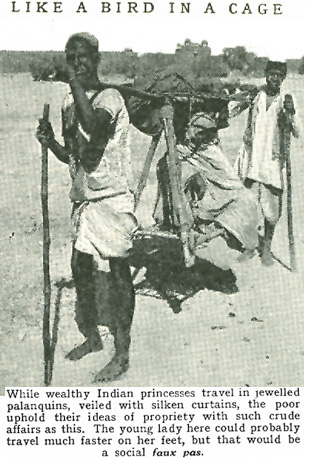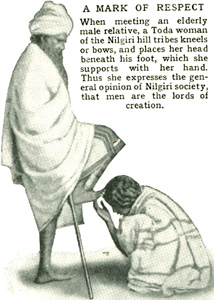
How the Country is Peopled

The population of India may be roughly placed in five groups:
(1) The descendants of the earliest known inhabitants of India, sometimes called Dravidians, who are represented by the savage Bhils and Gonds of central and western India, and by the Tamils of the south.
(2) The pure-blood descendants of the successive tides of Aryan invaders who conquered the Dravidian inhabitants, and who are best representedby the Rajputs.
(3) The great mass of Hindus formed by a mixture of the two preceding types.
(4) The descendants of the Mohammedan invaders who began pouring in the 7th. century.
(5) The Mongol or Tibetan types, which are found chiefly in the extreme north - east and in the Himalayas border regions.
(6) The people of Dravidian stock are short, dark, with curly or wavy hair and broad noses. At the other extreme are the Rajputs, tall, slender, and handsome.
The many separate languages of India can be generally divided into those derived from the ancient Sanskrit and those from the early Dravidian tongues, with a mixture of Malay and Chinese elements. In northern
India the interstate and intertribal dialect is Hindustani or Urdu, a blend of Persian with the dominant "Hindi" language—a pleasing combination. The chief religions of India are Hindu, Mohammedan, Buddhist, Sikh, Jain, Christian, and Parsee. Next to the crude beliefs of the primitive hill peoples, who see gods in rocks and trees, Hinduism is the oldest religion, and includes in its numerous sects more than 200 million persons. Hinduism has many forms, all of which are marked by a belief in many gods, and in universal reincarnation. The Sikhs form a religious community whose history dates back to the 16th century. Their faith is a curious mixture of Mohammedanism and Hinduism, and for a time they constituted a powerful and formidable military brotherhood. Today the Sikhs number somewhat more than three millions.
The Jains, on the other hand, tend to combine the Buddhist and Hindu religions. There are to-day about 1,250,000 Jains, and among them are many of the richest and most influential of Indian merchants. Their temples, among which are the famous ones on Mount Abu, are the finest in all India. The Parsees are descendants of Persian Zoroastrians — fire and sun worshippers, who fled to India to escape the Mohammedan massacres of the 7th century. They form now a rich merchant class of great power, despite the fact that their total number is only 100,000.
 The native Christians of India total about four millions, with the Roman Catholics far in the lead. The Mohammedans, with over 77 millions, form the largest religious group next to the followers of Hinduism (see Mohammed). The Buddhists, once exceedingly powerful in the land, have virtually disappeared from India proper; of the 11.000,000 counted in the empire today, all but about 300,000 are found in Burma.
The native Christians of India total about four millions, with the Roman Catholics far in the lead. The Mohammedans, with over 77 millions, form the largest religious group next to the followers of Hinduism (see Mohammed). The Buddhists, once exceedingly powerful in the land, have virtually disappeared from India proper; of the 11.000,000 counted in the empire today, all but about 300,000 are found in Burma.
The followers of Hinduism, which means at least two-thirds of the population, are grouped into countless castes which are half social, half religious. The caste system had its foundation in the old Aryan law, which divided the people into four classes —the priests or Brahmans, the warriors or Kshatriyas, the farmers or Vaisyas, and the labourers or Sudras. Tday these four original castes have been subdivided again and again until it is impossible to tell the number. Estimates vary between 2,000 and 3,000 distinct groups. The members of each handicraft, such as potters, jewellers, etc., tend to form separate castes which amount to trade guilds or unions.
The restrictions which surround members of a caste are innumerable. Generally speaking a person may not marry outside his caste, nor may he touch or associate with a member of a lower caste. Certain of the high-caste Hindus feel that they are profaned if even the shadow of a European or of the member of a lower caste falls upon them or their food or anything which belongs to them, and that they must thereupon perform elaborate rites of purification.
 Lower yet than the Sudras are the Pariahs or outcasts — a mass of 60,000,000 people, one-sixth of all the population of India. These "untouchables" are prohibited the use of public roads, bridges, and temples. They are forced to live outside the villages, and are allowed to enter only such despised occupations as street-sweeping and leather-working. So defiling is their touch that most Hindus would rather die than accept their help, and they are not even allowed to draw water from the public well.
Lower yet than the Sudras are the Pariahs or outcasts — a mass of 60,000,000 people, one-sixth of all the population of India. These "untouchables" are prohibited the use of public roads, bridges, and temples. They are forced to live outside the villages, and are allowed to enter only such despised occupations as street-sweeping and leather-working. So defiling is their touch that most Hindus would rather die than accept their help, and they are not even allowed to draw water from the public well.
The average Hindu is a peaceful, patient person. " Life in India," says one writer, " is regarded, in a very serious spirit by which even the children are subdued. You will never see them romping at play, and their games are of the quietest description. They take no pleasure whatever in teasing animals, and the birds and beasts of the household are extraordinarily tame. They are not so much petted as treated with the consideration due to members of the family; the cultivator appeals to his bullocks as ' my brothers.'
"To adults life offers few pleasures. Eating is a monotonous experience of the plainest dishes. Drinking, for the respectable, is limited to water. There are no attractions in sport or in physical exercises. Pairs and festivals give some excitement to the women who can attend them; but the men derive their pleasure rather from the gratification of a sense of dignity and importance than from the exercise of the functions of mind or body."
The Lowly Tasks of the Women The position of Indian women is not enviable. They are usually not permitted to learn to read and write, but are closely confined to their homes, where they perform all the menial tasks, 'They are not even permitted to sit down to meals with their husbands, but must serve them in silence and take what they leave. A recent census showed that more than 2,000,000 girls were married before the age of ten. The Sarda Act of 1930 penalises marriage until the bride is fourteen and the bridegroom eighteen. Although the practice of suttee, which allowed a Hindu widow to burn herself on the pyre of her husband, has been stamped out, a widow must keep her head shaved, give away all her jewels, and usually performs the most menial labour for her dead husband's family.
HINDUISM
The great majority of the peoples of India to-day are Hindus, and the name " Hinduism " is given to the strangely
complicated combination of religious
beliefs and social customs which govern
them.
The Four Social Castes These Vedas show us this early Aryan society divided into four social castes—the Brahmans or priestly caste, the Kshatriyas or soldier caste, the Vaisyas or farmer class, and the Sudras or labourers. Early in their history, the Brahmans gained political as well as religious supremacy over the Kshatriyas, and established the religion called Brahmanism, set forth in writings called " Brahmanas," which are commentaries on the old Vedas. Gradually, pantheism gave way to a religion of personal gods, of which Brahma, the " Father of all," Vishnu, the " Preserver," and Siva, the " Destroyer," were the most important.
As the native tribes of India were conquered one by one by the Aryans, the Brahmans found it wise to allow the new converts to retain many of their old beliefs and primitive religious customs. Opposition to this adulteration of the old religion was in part responsible for the foundation in the 6th century b.c. of Buddhism and Jainism, but the Brahmans prevailed.
A Multitude of
Sects
Most true followers of
Hinduism, however, continue to look upon the Brahman caste as their
leaders, and to observe broadly similar rules regarding
food, marriage, and burial. One of the most interesting of the Hindu beliefs is the
transmigration of souls, or "metempsychosis". According to this doctrine the soul of a person passes at death into some other creature,
either human or animal. If the person has led a good life, the soul goes
upward in the scale;a low-caste, for
instance, is reborn as a high-caste
if the person has led an evil life, the soul
may pass into the body of a dog or a pig or any other animal. This doctine was also one of the beliefs of the Greek, Pythagoras.
How Salvation is Achieved